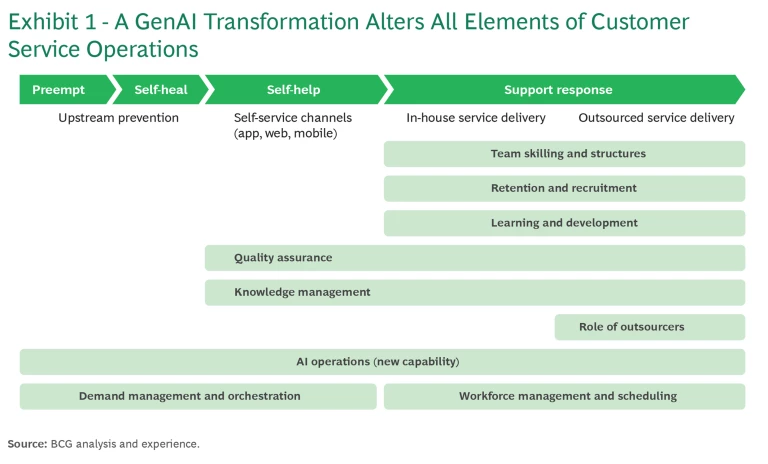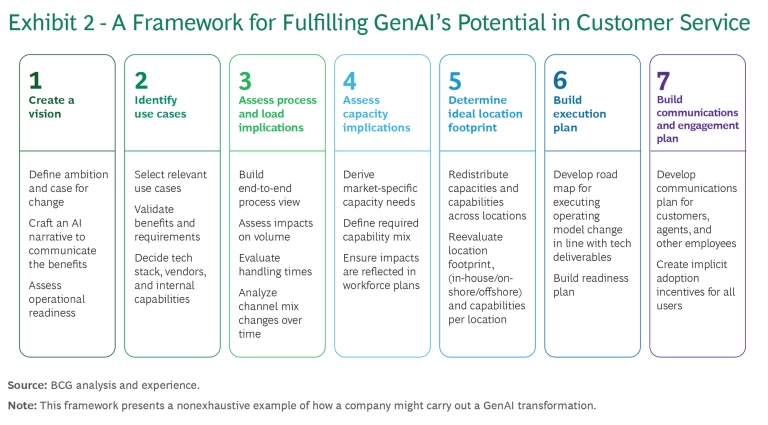While the scaling of use cases has dominated the headlines about generative AI (GenAI), leading customer service organizations are working to harness the technology’s full potential by fundamentally transforming their operating models.
Their goal is to make the customer service experience faster, more flexible, more customer friendly, and more proactive. These organizations believe that transforming their teams––how they work together, what kind of work they do, and how they are supported and motivated––will help them to realize ambitions for productivity improvements that reach as high as 80%. That goal lies well beyond the 15% to 30% that some organizations have achieved by scaling their initial GenAI use cases to date.
Our experience shows that such ambitious transformations will require more than additional AI-driven assistants and copilots, greater task automation, and improvements to technology and infrastructure. In line with BCG’s
10/20/70 rule
, a full-scale operational transformation will account for 70% of the effort to harness GenAI’s full potential, with 10% focused on algorithms and 20% on data and the technology backbone.
How GenAI Changes the Roles of Agents
Exhibit 1 shows the scope of a full GenAI transformation process across customer service operations, which covers the different ways that an organization can solve a customer’s problem, from upstream prevention to outsourced service delivery.

Team Skilling and Structures. We anticipate that the overall size of customer service organizations will be smaller, driven by natural attrition such as retirement more than by head-count reductions directly related to GenAI. At the same time, we expect individual agents to become more skilled and flexible, as automation and greater upstream interventions to prevent problems change the mix of demand and create a need for agents with a more “T-shaped” skill set. That means that most agents will cover a wider range of cases, while some will have the opportunity to further develop specialties that allow them to handle complex or less frequent requests.
The changes to the demand mix and the skill sets of agents also allow the organization to streamline the structure of frontline teams, enabling greater resourcing flexibility. Creating teams with that combination of fungibility and expertise means that human resources teams will need to retain and recruit talent with an evolved skill profile, improve training programs and knowledge management, and enhance quality.
Human resources teams will need to retain and recruit talent with an evolved skill profile, improve training programs and knowledge management, and enhance quality assurance.
Retention and Recruitment. Because some agents may fear that GenAI will make them redundant, employee retention will become paramount. Fortunately we have found that several benefits––the variety of work, the opportunity to develop AI skills, and greater autonomy to help customers––can defuse employees’ fears by increasing the “joy” and decreasing the “toil” in the agent’s role.
Having a smaller overall organization also puts a premium on retaining employees skilled in higher-level problem solving. In parallel, organizations need to recruit people who can navigate complex customer questions and solve problems on the spot. GenAI can help improve the selection process by generating case studies with simulated calls.
Learning and Development: We expect training to continue moving away from classroom instruction and toward on-the-job models. That approach will include personalized “bite-size” trainings supported by GenAI as well as peer-to-peer interactions. Agents will complete more of their onboarding and training at their desks, serving a mix of simulated and real customers. Onboarding will become more difficult, however, because GenAI tools make obsolete many kinds of example cases and problems used in initial training, since the technology itself resolves those problems. Therefore the training teams themselves will need new skills and tools to lead this transition.
Quality Assurance: Customer service organizations often monitor only 1% to 2% of total case volume, because the process typically requires manual effort or focused listening by an individual. GenAI now enables an organization to monitor up to 100% of cases. The associated influx of data can mean a step change in the quality of the customer experience. Translating this wealth of information into specific recommendations will require a new set of employee skills around data analytics.
Knowledge Management: GenAI tools need access to complete, accurate, and up-to-date data and insights. This elevates the role of the knowledge management teams that will need to ensure that access. To support that process, some leading companies have already changed the role of second-line or senior agents, who now spend as much as 30% of their time checking and updating content.
For many companies, outsourcers will play a crucial role in supporting the large-scale workforce changes that will emerge over the next few years.
Role of Outsourcers: For many companies, outsourcers will play a crucial role in supporting the large-scale workforce changes that will emerge over the next few years. The tasks that outsourcers handle may change significantly as GenAI alters or automates the simpler and more repeatable customer requests. We also expect AI to create new tasks suitable for outsourcing, though the underlying tradeoff decisions remain the same: Can outsourcers handle a given task more efficiently or cost-effectively than in-house teams?
Such efficiencies from GenAI can derive from the organization’s making its outsourcing partners more efficient, or the partners themselves taking independent actions to make themselves more efficient. In either case, companies might need to adjust their commercial model to ensure that a fair proportion of the benefits from GenAI translates into reduced costs paid to the outsourcer. That means being deliberate and transparent about the source and extent of efficiencies and renegotiating contracts with outsourcers if necessary to keep incentives aligned. If overall case volume declines, the organization will need to manage its outsourcer portfolio in a way that directs sufficient business to its preferred partners.
How GenAI Creates Demand for New Employee Roles
Customer service organizations will need to establish new employee roles to build, shape, and govern their AI tools. For example, companies will need people who can continuously improve the outputs of AI assistants and monitor chatbots for malicious prompts that could produce improper or detrimental responses. Many of these roles will require a high level of technical skill and will be closely integrated with the frontline rather than as back-office support. These new roles will provide an overarching governance structure for AI operations and enable the organization to capture efficiencies in workforce management and demand management that arise from implementing GenAI.
AI Operations: The family of AI operations roles will govern AI to ensure not only that it is secure, but also that it provides accurate answers in an appropriate tone, while delivering value for money. GenAI tools depend on underlying foundational models whose levels of performance, cost, and accessibility may change. The organization needs the flexibility to change foundational models if those levels become misaligned.
To provide superior customer experience, bots need the ability to make seamless transitions when issues require human intervention.
Workforce Management: To provide superior customer experience, bots need the ability to make seamless transitions when issues require human intervention. This creates a greater need for agents who are available on demand and leaves workforce management (WFM) teams with a smaller margin for error. To manage this risk, WFM teams can use advanced simulations and AI digital twins to model customer demand and more accurately plan how to allocate the higher skilled agents. Any agent can handle most tasks to a certain extent, and advanced routing can get calls to specialists when necessary. WFM teams will also need to build in operational resilience for scenarios when AI support becomes unavailable.
Demand Management: The same data that helps optimize how resources are allocated may also help companies with their demand management and orchestration, enabling companies to route a customer’s request to the best resource to solve it. GenAI enables customer service leaders to understand the reasons for customer contacts in more detail than ever before, including granular insights into who is calling and the root causes of their pain points.
Over time, a nimble, data-driven customer service organization can work closely with the rest of the business to
create truly differentiated customer experiences.
By analyzing interactions, matching patterns, and spotting trends that suggest addressable issues, they can create business cases to work with other functions––such as product, digital, marketing, and sales––to fix the root causes and help prevent upstream service issues. The analyses could, for example, demonstrate how a specific change to the sales process can reduce customer confusion and subsequent complaints.
Planning the Transformation of the Operating Model
To match the pace of technological change, companies should create and map out an AI vision for customer service operations that covers all the elements we’ve described, from team roles and AI operations to WFM and demand management, and across different future timelines.
One large technology company has launched pilots of GenAI agent-assist tools in their contact centers, yielding promising productivity improvements of 15%-20%.
One large technology company has launched pilots of GenAI agent-assist tools in their contact centers, yielding promising productivity improvements of 15%-20%. They were able to scale this impact across all contact centers globally by planning out the changes for customers, agents, supervisors, and service leaders over three distinct time horizons. This has enabled them to execute operational changes as new GenAI capabilities became available.
Exhibit 2 outlines a step-by-step framework that starts with creating the AI vision and ends with developing a communication and engagement plan. Underpinning the framework is a change management process that helps to instill a new mindset, support individual agents in their transition, and keep the transformation on track. Planning needs to begin while the organization is setting up its initial set of use cases, ensuring it begins to derive value from GenAI as the use cases roll out.

A successful transformation program is a cross-functional effort in which teams come together frequently with strong sponsorship and a mandate from senior leadership, ideally the CEO. This effort works best when teams––starting with senior leadership––shift from a “run the operations” mindset to a “run and continuously improve the system” mindset.
Note that the company’s vision for AI integration should emphasize the technology’s benefits, such as its ability to eliminate tedious tasks and improve the quality of the agent’s work experience. Successful implementations we’ve seen of a company’s vision integrate the frontline teams into the transformation process, involving them in the design, testing, and rollout of the tools, the operational transformation, and the change management.
The roles of agents will change, however. The twin effects of downsizing and upskilling will alter volumes and capacity over time, by skill and by location. This could lead to a shift in outsourcing or to consolidating locations, likely requiring coordination with other stakeholders such as works councils in some countries.
Pioneering customer service organizations are setting bolder ambitions for GenAI after seeing promising early improvements in agent productivity. But they won’t be able to realize those ambitions solely on the basis of better data and technology. The bulk of the improvement will come from an end-to-end transformation of the service organization’s operations. This transformation will define both the future quality of customer service as well as how efficiently the organization and its frontline teams can provide it. Companies that delay this transformation––or underestimate its importance––risk damaging their competitive position.











